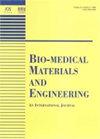Hemodynamic analysis of a curved artery based on microcirculation boundary.
IF 1
4区 医学
Q4 ENGINEERING, BIOMEDICAL
引用次数: 0
Abstract
BACKGROUND Microcirculation plays a key role in regulating blood flow but is not considered in previous research of hemodynamics. OBJECTIVE A curved artery model is established to study its hemodynamic characteristics based on microcirculation boundary. METHODS The hemodynamic model of a curved artery is constructed and simulated by computational fluid dynamics. The curved artery model is simulated by fluid-structure interaction. At the same time, a porous medium is used to simulate microcirculation as the outlet boundary. RESULTS The distribution characteristics of the blood flow velocity, the pressure and the wall shear stress in different sections at different time of the cardiac cycle are obtained. The results show that the velocities in curved arteries decrease and the pressures gradually increase. The blood flow velocity waveform and value are affected and they are sensitive to the microcirculation boundary. However, the pressure value is only affected by the microcirculation function. CONCLUSIONS This work is useful for researchers to deeply understand the hemodynamic characteristics of curved arteries. There is important clinical significance to analyze the pathogenesis of cardiovascular disease considering microcirculation function and its coupling effect.基于微循环边界的弯曲动脉血流动力学分析。
背景微循环在血流调节中起着关键作用,但在以往的血流动力学研究中并未被考虑。目的建立基于微循环边界的弯曲动脉模型,研究其血流动力学特性。方法建立弯曲动脉血流动力学模型,并用计算流体力学方法进行模拟。采用流固耦合法对弯曲动脉模型进行了模拟。同时,采用多孔介质作为出口边界模拟微循环。结果获得了心脏周期不同时段不同部位血流速度、压力和壁剪应力的分布特征。结果表明:弯曲动脉内流速逐渐减小,压力逐渐增大;血流速度波形和数值受影响,且对微循环边界敏感。而压力值仅受微循环功能的影响。结论本研究有助于研究人员深入了解弯曲动脉的血流动力学特征。结合微循环功能及其耦合效应分析心血管疾病的发病机制具有重要的临床意义。
本文章由计算机程序翻译,如有差异,请以英文原文为准。
求助全文
约1分钟内获得全文
求助全文
来源期刊

Bio-medical materials and engineering
工程技术-材料科学:生物材料
CiteScore
1.80
自引率
0.00%
发文量
73
审稿时长
6 months
期刊介绍:
The aim of Bio-Medical Materials and Engineering is to promote the welfare of humans and to help them keep healthy. This international journal is an interdisciplinary journal that publishes original research papers, review articles and brief notes on materials and engineering for biological and medical systems. Articles in this peer-reviewed journal cover a wide range of topics, including, but not limited to: Engineering as applied to improving diagnosis, therapy, and prevention of disease and injury, and better substitutes for damaged or disabled human organs; Studies of biomaterial interactions with the human body, bio-compatibility, interfacial and interaction problems; Biomechanical behavior under biological and/or medical conditions; Mechanical and biological properties of membrane biomaterials; Cellular and tissue engineering, physiological, biophysical, biochemical bioengineering aspects; Implant failure fields and degradation of implants. Biomimetics engineering and materials including system analysis as supporter for aged people and as rehabilitation; Bioengineering and materials technology as applied to the decontamination against environmental problems; Biosensors, bioreactors, bioprocess instrumentation and control system; Application to food engineering; Standardization problems on biomaterials and related products; Assessment of reliability and safety of biomedical materials and man-machine systems; and Product liability of biomaterials and related products.
 求助内容:
求助内容: 应助结果提醒方式:
应助结果提醒方式:


